How to configure the parental controls on your child’s cell phone
Parents can limit how long minors use their devices and what kind of content they can access

Teenagers on the internet face a wide range of potential dangers, from cyberbullying to communicating with strangers to accessing inappropriate content. Parental control applications are one way to ensure they use the internet safely and responsibly. Apple and Google devices both include settings to limit time in front of the phone screen, block applications and restrict access to adult content.
How long do they spend on the phone, and what do they do?
To protect teenagers, the Parental Mediation Guide by Safe Internet for Kids (IS4K) recommends staying on top of their day-to-day online activities. Parents can keep track of how long their children spend on the phone, what applications they use, how many times they unlock the device and even the number of notifications received. To consult the information on an Android device, open the settings and tap Digital Wellbeing and Parental Controls. On the iPhone, select the option Screen Time.
Control screen time
Parents can also limit how much time their child uses the app each day. If your devices have an Android operating system, the parent can download the application Family Link on their own phone and limit both screen time and the usage of certain apps. To configure those options, open Family Link, select the option “Controls” and activate the “Daily Limit” or “Application Limit.” Once the minor exceeds the established time limit, the device will be blocked so that notifications are not visible and the child can only access apps that the parent has pre-approved.
If your child has an iPhone, go into Settings and select the option “Screen Time” and “App Limits.” You can establish a maximum daily time limit for each application. It is also possible to set a limit for each day of the week, which could be useful if, for example, you want your child to use certain applications only on the weekends. The “Screen Time Password” option prevents the minor from bypassing the control. After they reach the time limit, the child cannot continue using the app unless they know the parent’s code.
Block purchases in app stores
To prevent your child from downloading certain applications on an Android, open the Play Store, go to settings and activate the “Parental Control” option. You will be asked to introduce a PIN code, which the device will request whenever the user attempts to download an app. There is also an option to block both paid applications and in-app purchases. To activate it, enter the settings within the Play Store and click on “Authentication” and “Require authentication for purchases.” Once the option “for all purchases made through Google Play on this device” is activated, when the minor tries to buy something, they will have to enter the Google account password before proceeding with the payment.
iPhones also have a feature to prevent children and teens from purchasing and downloading apps on iTunes and the App Store. To activate it, enter the “Screen Time” menu in the phone settings. Click on “Restrictions” and “Purchases in iTunes and App Store.” You can then prevent the device’s user from installing and deleting apps and making in-app purchases.
Limit access to adult content
“Our children can access a wide range of content on the internet that is harmful to their personal development,” IS4K says. That can include “disturbing images or videos, trends that promote negative values, health risks or bad habits, or information that is false or unverified.” Both Google and Apple have tools to prevent this.
On an Android mobile, parents can configure Google’s SafeSearch with the Family Link application to block results that “include explicit sexual content, such as pornography, bloody images and violence.” “Although no filter is completely foolproof, when SafeSearch is turned on, it helps filter explicit content from Google search results for all searches, whether they are images, videos, or websites,” the tech company says.
Apple’s content filtering “allows us to restrict web pages directed to an adult audience or limit access to only those websites that we determine, as well as configure privacy settings,” according to the Guide to Parental Control Tools developed by Spain’s Institute National Cybersecurity (INCIBE). To limit access to adult content in Safari and other apps on the device, go to the “Screen Time” tab, click on “Restrictions,” then on “Content Restrictions” and, finally, on “Web Content.” The parent can choose whether to “limit access to adult websites” or allow access only to certain websites.
How to control settings remotely
Although many of the aforementioned settings can be activated from the minor’s phone, there are also alternatives to configure such settings remotely. On an Android device, it is possible to use Google’s free parental control application, Family Link. “Its tools are easy to use and allow you to understand what your children are spending time on when they are with their devices or manage privacy settings, among other options,” says the Mountain View company.
Apple also offers parents an option to configure settings from their own mobile. To do this, you can use the “family” service, designed for up to six family members to share music, movies and subscriptions without having to use the same Apple ID. To create a group, you have to go to Settings, click on the name of the owner of the mobile —which appears at the top of the screen— and choose the “family” option.
Beyond all these parental control tools, it is essential for parents to share online activities with their children, foster critical thinking and create a climate of trust, according to IS4K’s Parental Mediation Guide. As its authors point out, gaining teens’ trust allows them to “know they can count on you if they have a problem online.”
Sign up for our weekly newsletter to get more English-language news coverage from EL PAÍS USA Edition
Tu suscripción se está usando en otro dispositivo
¿Quieres añadir otro usuario a tu suscripción?
Si continúas leyendo en este dispositivo, no se podrá leer en el otro.
FlechaTu suscripción se está usando en otro dispositivo y solo puedes acceder a EL PAÍS desde un dispositivo a la vez.
Si quieres compartir tu cuenta, cambia tu suscripción a la modalidad Premium, así podrás añadir otro usuario. Cada uno accederá con su propia cuenta de email, lo que os permitirá personalizar vuestra experiencia en EL PAÍS.
¿Tienes una suscripción de empresa? Accede aquí para contratar más cuentas.
En el caso de no saber quién está usando tu cuenta, te recomendamos cambiar tu contraseña aquí.
Si decides continuar compartiendo tu cuenta, este mensaje se mostrará en tu dispositivo y en el de la otra persona que está usando tu cuenta de forma indefinida, afectando a tu experiencia de lectura. Puedes consultar aquí los términos y condiciones de la suscripción digital.
More information
Archived In
Últimas noticias
NASA discovers Titan doesn’t have an ocean, but a ‘slushy ice layer’ that increases possibility of life
Innocence lost in the forest of the child soldiers: ‘Each leader of the armed group had his girls’
‘Fallout’ or how the world’s largest company turned an anti-capitalist apocalyptic Western into a phenomenon
From inflation to defending migrants: Eileen Higgins and Zohran Mamdani inaugurate the new Democratic resistance against Trump
Most viewed
- ‘El Limones’ and the growing union disguise of Mexican organized crime
- Christian Louboutin: ‘Young people don’t want to be like their parents. And if their parents wear sneakers, they’re going to look for something else’
- The low-cost creative revolution: How technology is making art accessible to everyone
- Liset Menéndez de la Prida, neuroscientist: ‘It’s not normal to constantly seek pleasure; it’s important to be bored, to be calm’
- A mountaineer, accused of manslaughter for the death of his partner during a climb: He silenced his phone and refused a helicopter rescue











































